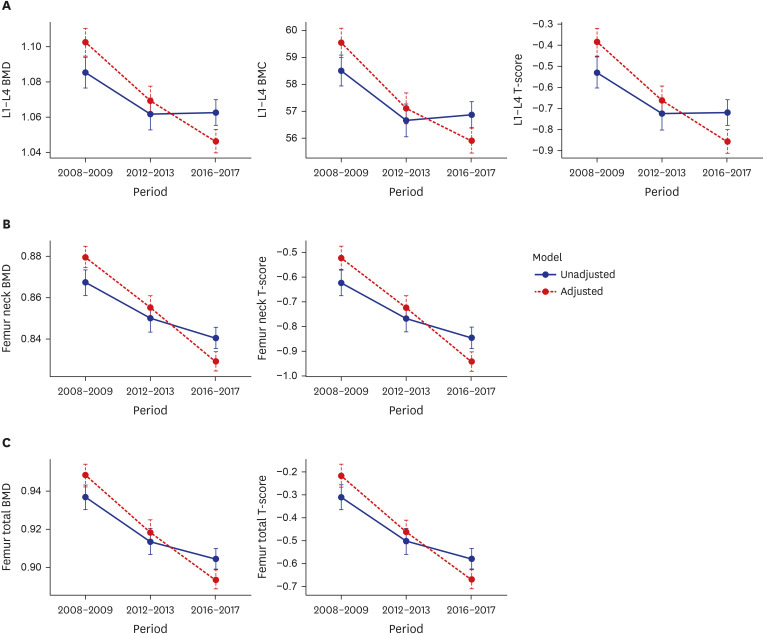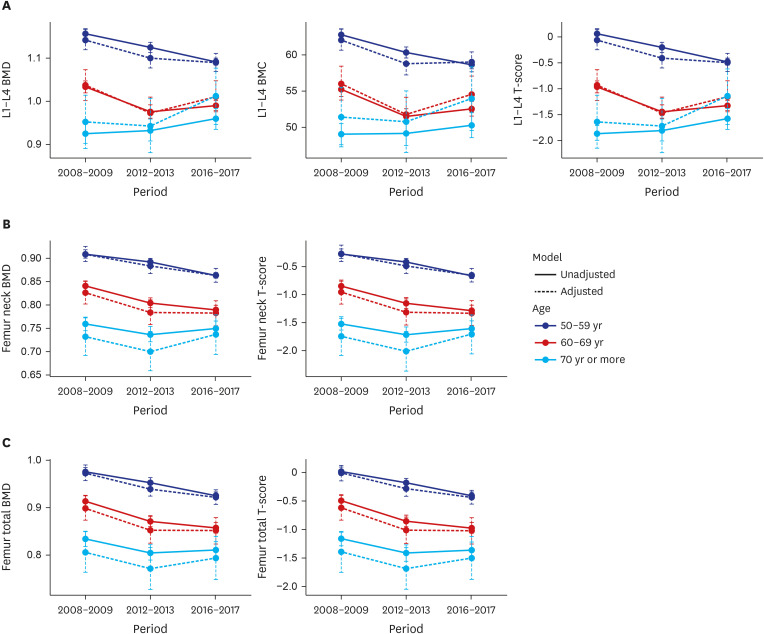J Korean Med Sci.
2023 Oct;38(42):e364. 10.3346/jkms.2023.38.e364.
Discordance in Secular Trends of Bone Mineral Density Measurements in Different Ages of Postmenopausal Women
- Affiliations
-
- 1Department of Family Practice and Community Health, Ajou University School of Medicine, Suwon, Korea
- 2Office of Biostatistics, Medical Research Collaborating Center, Ajou Research Institute for Innovative Medicine, Ajou University Hospital, Suwon, Korea
- 3Department of Biomedical Informatics, Ajou University School of Medicine, Suwon, Korea
- KMID: 2547564
- DOI: http://doi.org/10.3346/jkms.2023.38.e364
Abstract
- Background
Age-adjusted bone mineral density (BMD) in postmenopausal women decreases in developed countries whereas incidence of osteoporotic fracture decreases or remains stable. We investigated secular trends of bone density from 2008 to 2017 among different age groups of postmenopausal women.
Methods
We analyzed BMD data obtained from health check-ups of 4,905 postmenopausal women during three survey cycles from 2008 to 2017. We divided them into 3 groups by age (50–59 years, 60–69 years, and 70 years or more) and observed the transition of lumbar and femoral BMD in each group, before and after adjusting for variables that may affect BMD.
Results
Age-adjusted BMD, bone mineral content (BMC), and T-score demonstrated a declining trend over the survey period at lumbar spine (−2.8%), femur neck (−3.5%) and total femur (−4.3%), respectively. In the analysis for the age groups, the BMD, BMC, and T-score presented linear declining trend (−6.1%) in younger postmenopausal women while women aged over 70 or more showed linear increasing trends (+6.3%) at lumbar spine during the survey period. Femoral neck and total femur BMD demonstrated a declining linear trend only in the 50–59 and 60–69 years groups (−5.5%, −5.2%, respectively), but not in the 70 years or more group.
Conclusion
BMD in younger postmenopausal women has decreased considerably but has increased or plateaued in elderly women. This discordance of BMD trends among different age groups may contribute to decreased incidence of osteoporotic fracture despite a recent declining BMD trend in postmenopausal women.
Keyword
Figure
Reference
-
1. Osteoporosis prevention, diagnosis, and therapy. NIH Consens Statement. 2000; 17(1):1–45.2. Seeley DG, Browner WS, Nevitt MC, Genant HK, Scott JC, Cummings SR. Which fractures are associated with low appendicular bone mass in elderly women? The Study of Osteoporotic Fractures Research Group. Ann Intern Med. 1991; 115(11):837–842. PMID: 1952469.3. Ross PD, Davis JW, Epstein RS, Wasnich RD. Pre-existing fractures and bone mass predict vertebral fracture incidence in women. Ann Intern Med. 1991; 114(11):919–923. PMID: 2024857.4. Lewiecki EM, Wright NC, Curtis JR, Siris E, Gagel RF, Saag KG, et al. Hip fracture trends in the United States, 2002 to 2015. Osteoporos Int. 2018; 29(3):717–722. PMID: 29282482.5. Abtahi S, Driessen JH, Vestergaard P, van den Bergh J, Boonen A, de Vries F, et al. Secular trends in major osteoporotic fractures among 50+ adults in Denmark between 1995 and 2010. Osteoporos Int. 2019; 30(11):2217–2223. PMID: 31418061.6. Leslie WD, O’Donnell S, Jean S, Lagacé C, Walsh P, Bancej C, et al. Trends in hip fracture rates in Canada. JAMA. 2009; 302(8):883–889. PMID: 19706862.7. Crisp A, Dixon T, Jones G, Cumming RG, Laslett LL, Bhatia K, et al. Declining incidence of osteoporotic hip fracture in Australia. Arch Osteoporos. 2012; 7(1-2):179–185. PMID: 23225295.8. Giannini S, Sella S, Rossini M, Braghin D, Gatti D, Vilei MT, et al. Declining trends in the incidence of hip fractures in people aged 65years or over in years 2000–2011. Eur J Intern Med. 2016; 35:60–65. PMID: 27363306.9. Brauer CA, Coca-Perraillon M, Cutler DM, Rosen AB. Incidence and mortality of hip fractures in the United States. JAMA. 2009; 302(14):1573–1579. PMID: 19826027.10. Looker AC, Sarafrazi Isfahani N, Fan B, Shepherd JA. Trends in osteoporosis and low bone mass in older US adults, 2005–2006 through 2013–2014. Osteoporos Int. 2017; 28(6):1979–1988. PMID: 28315954.11. Imai N, Endo N, Shobugawa Y, Ibuchi S, Suzuki H, Miyasaka D, et al. A decrease in the number and incidence of osteoporotic hip fractures among elderly individuals in Niigata, Japan, from 2010 to 2015. J Bone Miner Metab. 2018; 36(5):573–579. PMID: 28884394.12. Chen FP, Shyu YC, Fu TS, Sun CC, Chao AS, Tsai TL, et al. Secular trends in incidence and recurrence rates of hip fracture: a nationwide population-based study. Osteoporos Int. 2017; 28(3):811–818. PMID: 27832325.13. Lee YK, Kim JW, Lee MH, Moon KH, Koo KH. Trend in the age-adjusted incidence of hip fractures in South Korea: systematic review. Clin Orthop Surg. 2017; 9(4):420–423. PMID: 29201294.14. Xu Y, Wu Q. Decreasing trend of bone mineral density in US multiethnic population: analysis of continuous NHANES 2005–2014. Osteoporos Int. 2018; 29(11):2437–2446. PMID: 30091065.15. Pinheiro MM, Reis Neto ET, Machado FS, Omura F, Yang JH, Szejnfeld J, et al. Risk factors for osteoporotic fractures and low bone density in pre and postmenopausal women. Rev Saude Publica. 2010; 44(3):479–485. PMID: 20549019.16. Hui SL, Slemenda CW, Johnston CC Jr. Age and bone mass as predictors of fracture in a prospective study. J Clin Invest. 1988; 81(6):1804–1809. PMID: 3384952.17. Amin S, Achenbach SJ, Atkinson EJ, Khosla S, Melton LJ 3rd. Trends in fracture incidence: a population-based study over 20 years. J Bone Miner Res. 2014; 29(3):581–589. PMID: 23959594.18. Ensrud KE. Epidemiology of fracture risk with advancing age. J Gerontol A Biol Sci Med Sci. 2013; 68(10):1236–1242. PMID: 23833201.19. Siris ES, Brenneman SK, Barrett-Connor E, Miller PD, Sajjan S, Berger ML, et al. The effect of age and bone mineral density on the absolute, excess, and relative risk of fracture in postmenopausal women aged 50–99: results from the National Osteoporosis Risk Assessment (NORA). Osteoporos Int. 2006; 17(4):565–574. PMID: 16392027.20. Ho-Pham LT, Chau PM, Do AT, Nguyen HC, Nguyen TV. Type 2 diabetes is associated with higher trabecular bone density but lower cortical bone density: the Vietnam Osteoporosis Study. Osteoporos Int. 2018; 29(9):2059–2067. PMID: 29967929.21. Huh JH, Choi SI, Lim JS, Chung CH, Shin JY, Lee MY. Lower serum creatinine is associated with low bone mineral density in subjects without overt nephropathy. PLoS One. 2015; 10(7):e0133062. PMID: 26207750.22. Hinton PS, Rector RS, Linden MA, Warner SO, Dellsperger KC, Chockalingam A, et al. Weight-loss-associated changes in bone mineral density and bone turnover after partial weight regain with or without aerobic exercise in obese women. Eur J Clin Nutr. 2012; 66(5):606–612. PMID: 22190134.23. Choi HS, Oh HJ, Choi H, Choi WH, Kim JG, Kim KM, et al. Vitamin D insufficiency in Korea--a greater threat to younger generation: the Korea National Health and Nutrition Examination Survey (KNHANES) 2008. J Clin Endocrinol Metab. 2011; 96(3):643–651. PMID: 21190984.24. Kang YW, Ko YS, Kim KY, Sung C, Lee DH, Jeong E. Trends in health-related behaviors of Korean adults: study based on data from the 2008–2014 community health surveys. Epidemiol Health. 2015; 37:e2015042. PMID: 26493778.25. Seo YB, Oh YH, Yang YJ. Current status of physical activity in South Korea. Korean J Fam Med. 2022; 43(4):209–219. PMID: 35903044.26. Martin D, Notelovitz M. Effects of aerobic training on bone mineral density of postmenopausal women. J Bone Miner Res. 1993; 8(8):931–936. PMID: 8213255.27. Wolff I, van Croonenborg JJ, Kemper HC, Kostense PJ, Twisk JW. The effect of exercise training programs on bone mass: a meta-analysis of published controlled trials in pre- and postmenopausal women. Osteoporos Int. 1999; 9(1):1–12.28. Park JH, Hong IY, Chung JW, Choi HS. Vitamin D status in South Korean population: seven-year trend from the KNHANES. Medicine (Baltimore). 2018; 97(26):e11032. PMID: 29952942.29. Choi SH, Kim DY, Koo JW, Lee SG, Jeong SY, Kang CN. Incidence and management trends of osteoporotic vertebral compression fractures in South Korea: a nationwide population-based study. Asian Spine J. 2020; 14(2):220–228. PMID: 31668050.
- Full Text Links
- Actions
-
Cited
- CITED
-
- Close
- Share
- Similar articles
-
- Differences in Bone Mineral Density between the Right and Left Hips in Postmenopausal Women
- The relationship of maturation value of vaginal epithelium and bone mineral density in postmenopausal women
- The Relations between Bone Density and Plasma Leptin in Postmenopausal Women
- Influence of the Reproductive Factor and Life Style Factor in Postmenopausal Women's Bone Mineral Density
- High Serum Osteopontin Levels Are Associated with Low Bone Mineral Density in Postmenopausal Women




